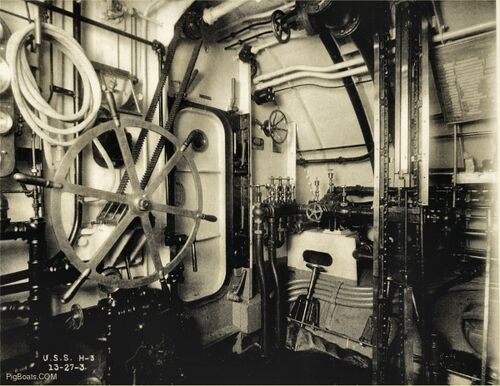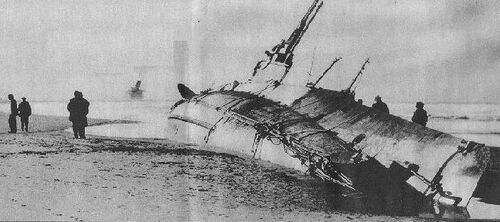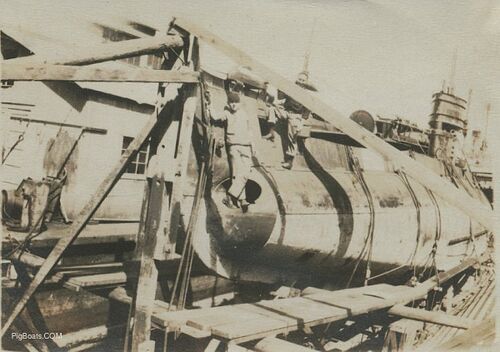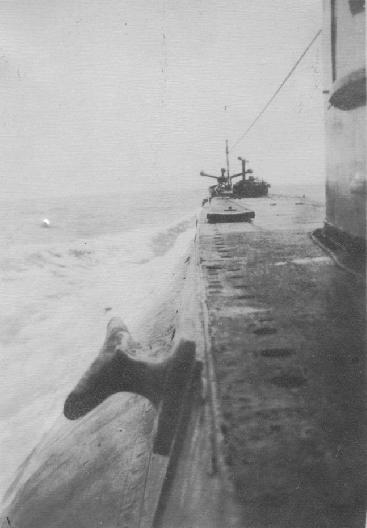H-3: Difference between revisions
Pbcjohnston (talk | contribs) (→Interior Photos: Added captions) |
No edit summary |
||
| Line 105: | Line 105: | ||
[[File:H-3 after bat compt.jpg|left|500px]] | [[File:H-3 after bat compt.jpg|left|500px]] | ||
The H-3 after battery compartment. The view is looking aft to the engine room door. This compartment was a combination of crew's berthing, galley, messing, and maneuvering room. The Astern - Stop - Ahead indicators for each engine/motor are on either side of the door. The shaft turns indicators for each shaft are just above the direction indicators. Electrical switching gear can be seen on each side of the compartment. | The H-3 after battery compartment. The view is looking aft to the engine room door. This compartment was a combination of crew's berthing, galley, messing, and maneuvering room. The Astern - Stop - Ahead indicators for each engine/motor are on either side of the door. The shaft turns indicators for each shaft are just above the direction indicators. Electrical switching gear can be seen on each side of the compartment. The Galley would be located in the forward port corner of the compartment consisting of a range, sink and a small counter space. | ||
<small>Photo courtesy of the National Archives.</small> | <small>Photo courtesy of the National Archives.</small> | ||
Revision as of 14:15, 6 November 2023
Construction and Trials

Photo courtesy of the National Archives.

The launch of the H-3 from the Moran Company building slip, July 3, 1913.
Image courtesy of the Seattle Post-Intelligencer Newspaper.

H-3 returning from Seattle to Bremerton, WA., March 1914. LT William R Munroe, the Commanding Officer, is on the bridge. H-3 had been refueling in Seattle and was returning to the Puget Sound Navy Yard. There is an unidentified cruiser in the background. The waterway seen is probably Sinclair Inlet as the land in the background (Port Orchard) still looks pretty much today as it does in this photo.
Photo courtesy of the National Archives.

H-3 running trials on Bellingham Bay, north of Seattle near the Canadian border, January 1914. The bay is calm, but the boat is running at a good clip and pushing up a large bow wave.
U.S. Navy photo.

Another view of the Bellingham Bay trials, from the port bow. H-3 had been commissioned at this point, but it appears as though there are several civilians aboard, probably Electric Boat or Moran employees observing the tests.
U.S. Navy photo.
Interior Photos

The H Class subs carried four torpedoes in their tubes and four reloads. These subs fired the Bliss-Levitt Mark 7 torpedo.
Photo courtesy of the National Archives.

H-3's torpedo room looking aft. The curtained areas to port and starboard are berthing for the Captain and Executive Officer. The two swingout stanchions have the notched arms for holding reload torpedoes in line with the tubes.
Photo courtesy of the National Archives.

The H-3's forward battery compartment looking forward. Torpedo tubes can be seen through the open watertight door. the photo is very dark and indistinct with the exception of the lockers and door. Two men can be made out in silhouette but that is about all. A large safe can be seen attached to the bulkhead to the right of the door. There is a fresh water tank on the right with an oval-shaped bolted down access cover.
Photo in the private collection of Ric Hedman.

H-3's forward battery compartment looking aft. The door leads to the Control Room. On the right is a small room that according to the ship's drawings is the radio room. The two large pipes are the ventilation piping for the battery under the deck. This is to help prevent the buildup of hydrogen gas in the battery well and prevent explosions.
Crew bunks are seen at the top in the photo. The bunks to the left have canvas curtains and are a single row of bunks. The bunks on the right are two deep and the inner row has been "triced up", meaning they have been folded away to make room for other functions.
The drawings show that only part of the compartment is paneled and the forward end is not as noted in the photo above this one. The benches are storage lockers for the crew's personal gear. In the lower left corner of the photo is a portable electric heater, the cord for which can be seen draped in the upper left and followed down to the heater.
Unseen in the photo to the left of the door and outboard any paneling is the motor for the trim pump, controls for which are located in the control room. This pump is used to move water around the submarine for ballast and pumping bilges.
Note the tool kit on the bulkhead to the right of the door. It has three open end wrenches, two spanner wrenches, two T-wrenches and at least two screwdrivers. There is one of two possibilities for this kit, the first being for damage control, the 2nd for use by the electricians in the battery well. The presence of the spanner wrenches indicate that this is a damage control kit, as the spanners are used for coupling and decoupling fire hoses. If these are brass tools then it might be a battery well tool kit.
We are yet to discover what the huge wrench under the tool kit is used for. The only reasons we can come up with would involve use in the engineroom.
Photo in the private collection of Ric Hedman.

Control room of the H-3 looking forward and to the starboard corner. The door leads to the forward battery compartment. The helm wheel is in the center, with a mirror so that the helmsman can see the dial of the magnetic compass above him. Note the chain leading up from the helm shaft to a shaft in the overhead that is connected to the rudder rams in the stern. On the right is the ballast control manifold, used to move ballast water to various tanks to balance the foward/aft trim and the boat's overall buoyancy. Directly above the manifold on the forward bulkhead are the controls for the trim pump.
Photo in the private collection of Ric Hedman.

H-3's control room looking to port. On the left are the wheels for controlling the stern planes (left) and the bow planes (right). In between them are the depth gauges and bubble levels. The round hull section beneath the wheels is actually the top of the port side of the auxiliary ballast tank. On the right is the high pressure air manifolds, used to blow ballast tanks to surface the boat.
Photo in the private collection of Ric Hedman.

The H-3's control room is actually a small space, and this view is of the port aft corner. The stern planes wheel can be seen in the center right.
Photo in the private collection of Ric Hedman.

The H-3 after battery compartment. The view is looking aft to the engine room door. This compartment was a combination of crew's berthing, galley, messing, and maneuvering room. The Astern - Stop - Ahead indicators for each engine/motor are on either side of the door. The shaft turns indicators for each shaft are just above the direction indicators. Electrical switching gear can be seen on each side of the compartment. The Galley would be located in the forward port corner of the compartment consisting of a range, sink and a small counter space.
Photo courtesy of the National Archives.

This closeup gives a better view of the equipment on the aft bulkhead in the after battery compartment. This photo appears to have been taken at 5:25 pm indicated by the clock in the upper left corner.
Photo courtesy of the National Archives.

This is a later view of the same scene. It is unfortunate that the photo quality is poor. Through the door on the left can be seen the starboard diesel engine. An electrical panel is on the left where the man is working.
In the overhead on either side of the door can be seen two dark long rods or shafts. The one on the left is the mechanical drive shaft for the rudder. The one on the right is for the operation of the stern planes.
Photo courtesy of Carolyn Fields Snider whose uncle, Harry Fields served on the H-3.

The H-3's engine room looking aft between the two NELSECO Model 240V8FS engines. Between the engines a large vertical tube can be seen. This is the tube that housed the Allied Signal Bell. These used to be mounted on the top of submarines but in later boats this was mounted upside down in a tube with the bell on the bottom. It is believed the H-3 was the last submarine with this feature.
On either side of the tube near the bottom are seen the rounded shapes of the two 600 horsepower main electric motors for charging the batteries and driving the submarine underwater. Above and behind the motors are the two air compressors for charging the air banks. These operate off propeller shaft rotations.
In the overhead can be seen the continuation of the two long control rods or shafts. The one on the left is the mechanical drive shaft for the rudder. The one on the right is for the operation of the stern planes.
Photo courtesy of Carolyn Fields Snider whose uncle, Harry Fields served on the H-3.

The H-3's engine room looking forward between the two NELSECO Model 240V8FS engines. In the foreground are the two 600 Horsepower main electric motors for charging the batteries and driving the submarine underwater. Barely seen at the far end of the compartment, in the glare, is the door into the after battery compartment.
Photo courtesy of Carolyn Fields Snider whose uncle, Harry Fields served on the H-3.
First Grounding and Drydocking

The photo that is normally seen of this incident is with the tide high. We have not seen this low tide before.
Photo in the private collection of Ric Hedman



Early Operations

When I saw this photo I knew I had to own it. Hard to see but there is a second seagull sitting on a periscope top on the sub behind this one.
These are fixed length, non retracting periscopes. They do rotate to let the observer check a 360 field of view. It is also noted that the ships whistles are braced to the number 2 (taller) periscope barrel on both subs seen here.
The long skinny flags are US Navy Commissioning Pennants. Once a vessel has been accepted by the Navy it is placed "In Commission" and this pennant, consisting of a blue field with white stars and a single red and a single white stripe with "swallow Tail" end is raised on the vessel.
Photo in the private collection of Ric Hedman
Commissioning Pennant US Navy Photo





Eureka, California Grounding, December 1916/January 1917

Photo in the private collection of Ric Hedman





Later Operations, 1917-1922














Page created by:
Ric Hedman & David Johnston
1999 - 2023 - PigBoats.COM©
Mountlake Terrace, WA, Norfolk, VA
webmaster at pigboats dot com

